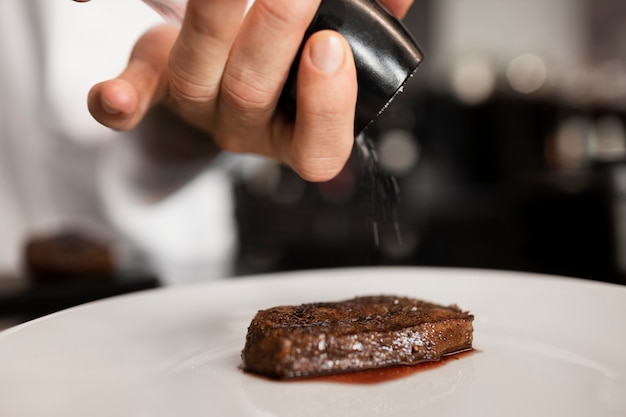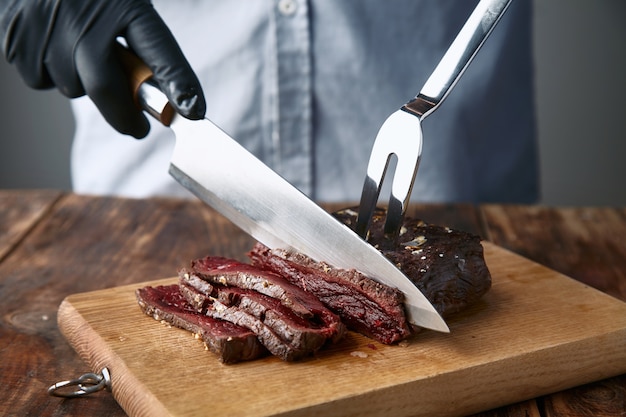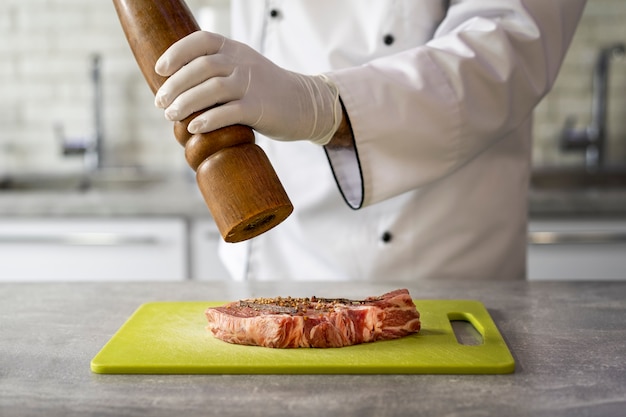There's a certain magic to a perfectly cooked wagyu steak. The rich marbling, the melt-in-your-mouth tenderness, the explosion of flavour – it's a culinary experience unlike any other. But achieving that restaurant-worthy steak at home can seem daunting, especially when you're dealing with a cut of meat as precious as Wagyu. No worries, mate! I've got you covered. This guide is your roadmap to nailing Wagyu at home, packed with tips, tricks, and even some personal experiences – the good, the bad, and the downright delicious. Let's get cooking!
(Part 1) Choosing Your Wagyu: A Matter of Taste and Preference

You can't talk about Wagyu without first talking about the cut itself. It's not just any beef, it's a breed renowned for its incredible marbling, a characteristic that translates to that incredible flavour and tenderness we all crave. I've been obsessed with Wagyu for years, and I've learned a thing or two about picking the right cut.
Navigating the Wagyu Family: Understanding the Cuts
The world of Wagyu cuts can seem like a foreign language, but once you break it down, it's surprisingly simple. Here's a quick guide to the most popular cuts and what they excel at:
- Rib Eye: This is the undisputed king of Wagyu. Its richness and marbling are legendary. Think of it as the ultimate indulgence, perfect for grilling, pan-searing, or even roasting. If you're looking for maximum flavour and tenderness, this is your go-to.
- Striploin: A slightly leaner option than Rib Eye, but still packs a punch. The Striploin offers a wonderful balance of flavour and tenderness, making it ideal for grilling, pan-searing, or even grilling.
- Sirloin: A classic choice known for its slightly firmer texture and robust flavour. It holds up well to grilling or pan-searing, and it's a fantastic choice for a smaller steak if you're not planning a full-blown feast.
- Tenderloin: The epitome of tenderness, the Tenderloin is prized for its buttery texture and delicate flavour. It's often used for filet mignon, and it's best suited for pan-searing or grilling.
- short ribs: A cut that's all about flavour and richness. Short Ribs are loaded with marbling, making them perfect for slow cooking or braising, where their flavour can really shine. If you're looking for a hearty, melt-in-your-mouth experience, Short Ribs are your answer.
Beyond the Cut: Decoding the Grade
Now that you've got your sights set on a particular cut, it's time to choose a grade. Wagyu is graded based on its marbling, and a higher grade means more fat, which translates to a richer, more flavourful experience. Here's a rundown of the major grading systems:
- BMS (Beef Marbling Standard): This is the traditional Japanese system, where Wagyu originated. The scale ranges from 1 to 12, with 12 being the most marbled. If you're a serious Wagyu enthusiast, BMS is your language.
- AU (Australian) and US Grading: These systems are similar to BMS, with higher grades indicating more marbling. In both systems, look for "Fullblood" Wagyu for the most intense marbling and luxurious experience.
Personally, I love the luxury of a BMS 9 or higher. It's like a flavour party in your mouth! But if you're looking for a more balanced experience, a BMS 6 or 7 is still absolutely delicious. Ultimately, the choice is yours. Consider your budget and your taste preferences – Wagyu offers a range of experiences to suit every palate.
(Part 2) The Art of Patience: Bringing Your Wagyu to Room Temperature

So, you've got your beautiful Wagyu, but don't rush into cooking it just yet! This is where the importance of patience comes in. Bringing your steak to room temperature is crucial for achieving even cooking. It might seem like a small detail, but it makes a world of difference.
Think of it this way: You wouldn't want to jump into a freezing cold pool, would you? Your steak deserves a chance to acclimate, too. A cold steak won't cook evenly. The outside will sizzle, while the inside remains cold, resulting in a tough, disappointing chew. By bringing it to room temperature, you ensure the heat penetrates evenly, leading to a perfectly cooked steak, juicy, tender, and bursting with flavour.
How long should you let it sit? About 30 minutes to an hour is ideal, depending on the thickness of your steak. Simply remove it from the fridge and place it on a plate, uncovered, on your counter. No need to worry about it going bad – it's just getting ready for its big moment.
Unlocking the Science: Why Room Temperature Matters
Remember those science classes you swore you'd never use? Well, there's actually science behind this. Bringing the steak to room temperature allows the muscle fibers to relax, making it more tender. It also helps the fat render more evenly, contributing to the juicy, flavorful experience we all crave. See? Science can be delicious!
(Part 3) The Magic of Simple Seasoning: Letting the Wagyu Shine

Your Wagyu is ready to go, but before you start getting too excited, let's talk seasoning. This is a crucial step that can make or break your Wagyu experience. Keep it simple, but keep it right. You want to enhance the natural beauty of the Wagyu, not overpower it.
Salt: The Key to a Crusty, Flavorful Delight
Salt is your best friend when it comes to Wagyu. It draws out moisture, creating a crispy crust that intensifies the meat's natural flavour. I love using kosher salt, but sea salt works just fine. Season generously, but don't overdo it. You want to taste the meat, not just the salt.
When to salt? That's a topic of endless debate among steak enthusiasts, but I prefer to salt my steak about 30 minutes before cooking. It gives the salt time to penetrate the meat and work its magic. If you're short on time, though, salting right before you start cooking is perfectly acceptable.
Pepper: Adding a Touch of Spice
Freshly ground black pepper is a classic companion to Wagyu's rich flavour. I prefer a coarse grind, but you can use whatever suits your taste. Just a light dusting is all you need to add a little oomph to the party.
Some folks like to add a pinch of garlic powder or onion powder to their seasoning blend. Go ahead and experiment, but remember – less is more. Let the Wagyu's natural flavour shine through.
Oil: The Secret to Crispy Perfection
A little bit of oil is all you need to ensure a crispy crust and prevent your steak from sticking to the pan. I usually go for neutral-flavored oils like avocado oil or grapeseed oil, but you can use olive oil if you like. Just a thin layer is all you need.
The Big Don'ts: Avoiding Flavor Overkill
Remember, Wagyu is a flavorful star, so keep things simple. Avoid strong marinades or heavy sauces that can drown out its natural goodness. And steer clear of pre-made steak seasoning mixes – they're often loaded with unnecessary additives that can mask the true flavour of your Wagyu. Keep it real, keep it simple, and trust in the magic of the Wagyu.
(Part 4) Mastering the Heat: Choosing Your Cooking Method
Now, you're ready to conquer the heat. This is where the magic happens, and it all boils down to getting that perfect sear and maintaining the right temperature throughout the cooking process. It's a delicate dance, but with the right approach, you can become a master of Wagyu.
The cast iron pan: Your Reliable Kitchen Ally
A cast iron pan is your go-to for cooking Wagyu. It holds heat beautifully, creating an even sear that locks in the juices and develops a gorgeous, crispy crust. Get your pan screaming hot – you want it smoking, not burning. Be careful not to burn the oil!
The Grill: Embracing the Outdoor Experience
If you're a grill master, Wagyu is your playground. I love grilling Wagyu during the summer months, especially when the weather is warm and inviting. Just remember to preheat your grill to medium-high heat, and watch out for flare-ups. Those beautiful fats can ignite quickly, so be prepared.
The Oven: A Versatile Alternative
The oven is another great option for cooking Wagyu, especially if you're aiming for a more even cook. Pre-heat your oven to a high temperature, about 450°F (230°C), and use a cast iron pan to sear the steak before transferring it to the oven. This method provides a nice sear on the outside while keeping the steak juicy and tender on the inside.
The Flip: The Moment of Truth
Don't be shy about flipping your steak! Once you've achieved a nice, crispy crust on one side, gently flip it over to sear the other side. Avoid poking or pressing on the steak, as this can release juices and make it tougher.
(Part 5) Temperature is King: Achieving Your Desired Doneness
You're almost there! It's time to get that internal temperature just right. This is where your trusty meat thermometer comes in. It's the key to unlocking a perfectly cooked Wagyu steak.
Internal Temperature Guide: A Cheat Sheet for Steak Success
Here's a handy guide to achieving your desired level of doneness:
| Doneness | Internal Temperature (°F) | Internal Temperature (°C) |
|---|---|---|
| Rare | 125-130 | 52-54 |
| Medium-Rare | 130-135 | 54-57 |
| Medium | 140-145 | 60-63 |
| Medium-Well | 150-155 | 65-68 |
| Well-Done | 160 | 71 |
Remember, Wagyu's marbling means it can cook a bit faster than regular beef, so keep a close eye on your thermometer. If you're unsure, always err on the side of undercooked. You can always cook it a little longer, but you can't undo overcooking.
(Part 6) Resting: The Final Step to Tenderness
You've seared it, you've cooked it, now it's time for the final touch: resting. Resting your Wagyu is essential for even distribution of juices and a deliciously tender, juicy steak. I know, it's hard to wait, but trust me – it's worth it!
How long should you let it rest? About 10 minutes is a good rule of thumb. Wrap your steak loosely in foil and let it sit on a cutting board. This allows the juices to redistribute throughout the meat, resulting in a more tender and flavorful steak.
(Part 7) Slicing: Presenting Your Wagyu Masterpiece
It's time to slice your Wagyu masterpiece. This is your final act, and it should be done with care.
The Right Tools for the Job
Use a sharp knife, preferably a chef's knife or a carving knife, to ensure clean, even slices. A dull knife will crush the meat, leading to a less than desirable texture.
The Right Technique for Tenderness
Slice against the grain, meaning across the direction of the muscle fibers. This helps break down the muscle fibers and makes the steak even more tender. If you're unsure about the grain, look at the surface of the steak. The grain runs in the same direction as the lines you see.
The Right Presentation for a Stunning Finish
Now, you're ready to present your perfectly cooked Wagyu. Arrange the slices on a platter or plate, and consider adding a few side dishes to complement the flavour. Some classic pairings include roasted vegetables, creamy mashed potatoes, or a simple green salad.
(Part 8) Wagyu Steak: Beyond the Basics
Now that you're equipped with the basics, let's explore a few exciting ways to elevate your Wagyu experience.
Adding a Touch of Luxury: Elevated Sauces
For a truly luxurious experience, consider pairing your Wagyu with a rich and flavorful sauce. A classic red wine reduction, a creamy mushroom sauce, or a simple béarnaise sauce can elevate your dish to new heights.
Wagyu Beyond Steak: A culinary adventure
Think outside the steak! Wagyu is incredibly versatile and can be used in a variety of dishes. Try it in a burger, a stir-fry, or even a pasta dish. The marbling adds a luxurious touch to any recipe.
(Part 9) FAQs: Answering Your Burning Questions
Let's address some common questions about Wagyu steak:
Is Wagyu steak expensive?
Yes, Wagyu is considered a premium beef, so it's generally more expensive than traditional beef. It's an investment in flavour and quality. However, consider it a special occasion treat – you deserve it!
How do I know if Wagyu is real?
Look for labels that indicate the breed and grading, like "Fullblood Wagyu" or "BMS 9 ." Reputable retailers should be able to provide you with information about the origin and quality of their Wagyu.
What's the best way to store Wagyu?
Store your Wagyu in the refrigerator for up to 3-4 days. Wrap it tightly in plastic wrap or butcher paper to prevent it from drying out.
Can I freeze Wagyu?
Yes, you can freeze Wagyu, but it's best to freeze it for a shorter period, like 2-3 months. Freezing can affect the texture slightly, but it's a good option if you need to store it for a while.
What are some good side dishes for Wagyu steak?
Wagyu pairs well with a variety of side dishes, including roasted vegetables, creamy mashed potatoes, asparagus, or a simple green salad. Experiment and find your favorites!
And there you have it, your ultimate guide to Wagyu steak at home. It's all about embracing the techniques, trusting your instincts, and most importantly, having fun in the kitchen. Now go forth and conquer the world of Wagyu, one delicious steak at a time!
Everyone is watching

Corn on the Cob: The Ultimate Guide to Perfectly Cooked Ears
Healthy MealsAh, corn on the cob. Just the name evokes images of sunny days, barbecues, and that sweet, juicy flavour that ...

Perfect Pork Roast Oven Cooking Time: A Guide to Delicious Results
Healthy MealsThere's something truly satisfying about a perfectly roasted pork. The aroma alone is enough to make your mout...

Ham Cooking Time: How Long to Bake, Smoke, or Boil a Delicious Ham
Healthy MealsAh, ham. It's a classic, isn't it? A real crowd-pleaser, especially around holidays. And when done right, it'...

Scallops: The Ultimate Guide to Perfect Cooking
Healthy MealsAh, scallops. Those delicate, sweet, and utterly delicious morsels of the sea. They hold a special place in my...

Spaghetti Squash: The Ultimate Guide to Cooking and Serving
Healthy MealsRemember that time you saw spaghetti squash at the supermarket, looking all bumpy and strange, and thought, "W...
